Thermal and Economic Analysis of Heat Exchangers as Part of a Geothermal District Heating Scheme in the Cheshire Basin, UK
Abstract
:1. Introduction
2. Method
2.1. Thermal Analysis of the Heat Exchanger
2.1.1. Counter-Current Flow Heat Exchangers
2.1.2. Co-Current Flow Heat Exchangers
2.2. Economic Modelling
| Algorithm 1:Determining the optimal surface area. |
| Input: Parameters listed in Table 1. Output: Optimal surface area and net profit 1: For A = 1:2000; % incremental increase in surface area (m2) 2: Solve for temperature of the geothermal fluid out (Equation (1)) 3: Solve for temperature of the clean fluid out the heat exchanger (Equation (2)) 4: Solve for the net profit (Equation (7)) 5: end 6: Identify the largest net profit (NKmax) and respective surface area (A) |
2.3. Parameterisation
| Parameter | Value |
|---|---|
| Flow rate of geothermal fluid (mh) | 80 kg/s |
| Flow rate of circulating fluid (mc) | 40 kg/s |
| Inlet temperature of geothermal fluid (Thin) | 67 °C (min) and 86 °C (max) [4,23,24] |
| Inlet temperature of circulating fluid (Tcin) | 30 °C [27] |
| Return temperature of circulating fluid (Tcout) | 48.5 °C (min) and 58 °C (max) |
| Specific heat capacity of water (Cp) | 4200 J/kg K |
| Heat transfer coefficient (U) | 4000 W/m2 °C [18,27] |
| Boiler efficiency (η) | 0.85 [29,30] |
| Cost of heat exchanger per unit area (Ic) | 50 £/m2 |
| Lower heating value of fuel (Hu) | 43,000 kJ/kg [31] |
| Fuel cost (F) | 0.49£ per litre |
| Interest rate (i) | 0.01 [32] |
| Lifetime (n) | 25 years |
3. Results
3.1. High Input Temperature of Geothermal Fluid
3.2. Low Input Temperature of Geothermal Fluid
3.3. Economic Analysis of Varying Heat Transfer Area for Counter-Current Flow Heat Exchangers
3.3.1. Low Temperature Geothermal Inlet Fluid
3.3.2. High Temperature Geothermal Inlet Fluid
3.3.3. Comparison of Output Temperatures and Regression Models
4. Discussion
4.1. Implications to Other Geothermal DHN across the UK
| Location | Temperature (°C) | Depth (km) | Net Profit for 10 L/s Flow Rate (Million £/Year) | Net Profit for 40 L/s Flow Rate (Million £/Year) | Temperature and Depth Reference |
|---|---|---|---|---|---|
| North Pennine Batholith (Northeast England) | 100 | 3 | 1.0345 | 3.918 | [34] |
| Wessex Basin (Souhampton) | 74 | 1.725 | 0.6498 | 2.3793 | [5] |
| Cornubian Granite (Rosemanowes) | 90 | 2.175 | 0.8865 | 3.3262 | [38] |
| Larne Basin (N. Ireland) | 91 | 2.873 | 0.9013 | 3.3853 | [38] |
4.2. Regression Analysis Reliability
4.3. Considering the Cost to Drill a Geothermal Doublet
5. Conclusions
Author Contributions
Funding
Institutional Review Board Statement
Informed Consent Statement
Data Availability Statement
Acknowledgments
Conflicts of Interest
Nomenclature
| Mass flow rate of geothermal fluid | (mh) |
| Mass flow rate of circulating fluid | (mc) |
| Inlet temperature of geothermal fluid | (Thin) |
| Inlet temperature of circulating fluid | (Tcin) |
| Return temperature of circulating fluid | (Tcout) |
| Specific heat capacity of water | (Cp) |
| Heat transfer coefficient | (U) |
| Boiler efficiency | (η) |
| Cost of heat exchanger per unit area | (Ic) |
| Lower heating value of fuel | (Hu) |
| Fuel cost | (F) |
| Interest rate | (i) |
References
- Björnsson, O.B. Geothermal District Heating. In International Workshop on Direct Use of Geothermal Energy; Chamber of Commerce and Industry of Slovenia: Ljubliana, Slovenia, 1999; Available online: https://geothermalcommunities.eu/assets/elearning/5.16.1999-Geothermal-District-Heating.pdf (accessed on 5 March 2020).
- Rollin, K.E.; Kirby, G.A.; Rowley, W.J.; Buckley, D.K. Atlas of Geothermal Resources in Europe: UK Revision; Technical Report WK/95/07; British Geological Survey: Nottingham, UK, 1995. [Google Scholar]
- Hirst, C.M.; Gluyas, J.G.; Adams, C.A.; Mathias, S.A.; Bains, S.; Styles, P. UK Low Enthalpy Geothermal Resources: The Cheshire Basin. In Proceedings of the World Geothermal Congress, Melbourne, Australia, 19–25 April 2015. [Google Scholar]
- Downing, R.A.; Gray, D.A. Geothermal Energy the Potential in the United Kingdom; BGS, National Environment Research Council: Nottingham, UK, 1986. [Google Scholar]
- Barker, J.A.; Downing, R.A.; Gray, D.A.; Findlay, J.; Kellaway, G.A.; Parker, R.H.; Rollin, K.E. Hydrogeothermal studies in the United Kingdom. Q. J. Eng. Geol. Hydrogeol. 2000, 33, 41–58. [Google Scholar] [CrossRef]
- Busby, J.P. Geothermal prospects in the United Kingdom. In Proceedings of the World Geothermal Congress, Bali, Indonesia, 25–29 April 2010. [Google Scholar]
- Busby, J. Geothermal energy in sedimentary basins in the UK. Hydrogeol. J. 2014, 22, 129–141. [Google Scholar] [CrossRef] [Green Version]
- Routledge, K.; Williams, J.; Lehdonvirta, H.; Kuivala, J.-P.; Fagerstrom, O. Heat Network Mapping for Leighton West; Report number: 298-692; A Report Prepared for Cheshire East Council; Crewe, UK, 2014. [Google Scholar]
- Chuanshan, D.; Jun, L. Optimum design and running of PHEs in geothermal district heating. Heat Transf. Eng. 1999, 20, 52–61. [Google Scholar] [CrossRef]
- Ağra, Ö.; Erdem, H.H.; Demir, H.; Atayılmaz, Ş.Ö.; Teke, İ. Heat capacity ratio and the best type of heat exchanger for geothermal water providing maximum heat transfer. Energy 2015, 90, 1563–1568. [Google Scholar] [CrossRef]
- Shi, Y.; Song, X.; Li, G.; Li, R.; Zhang, Y.; Wang, G.; Zheng, R.; Lyu, Z. Numerical investigation on heat extraction performance of a downhole heat exchanger geothermal system. Appl. Therm. Eng. 2018, 134, 513–526. [Google Scholar] [CrossRef]
- Brown, C.S.; Cassidy, N.J.; Egan, S.S.; Griffiths, D. Numerical modelling of deep coaxial borehole heat exchangers in the Cheshire Basin, UK. Comput. Geosci. 2021, 152, 104752. [Google Scholar] [CrossRef]
- Sliwa, T.; Leśniak, P.; Sapińska-Śliwa, A.; Rosen, M.A. Effective Thermal Conductivity and Borehole Thermal Resistance in Selected Borehole Heat Exchangers for the Same Geology. Energies 2022, 15, 1152. [Google Scholar] [CrossRef]
- Amanowicz, Ł.; Wojtkowiak, J. Comparison of Single-and Multipipe Earth-to-Air Heat Exchangers in Terms of Energy Gains and Electricity Consumption: A Case Study for the Temperate Climate of Central Europe. Energies 2021, 14, 8217. [Google Scholar] [CrossRef]
- Mirzaei, M.; Hajabdollahi, H.; Fadakar, H. Multi-objective optimization of shell-and-tube heat exchanger by constructal theory. Appl. Therm. Eng. 2017, 125, 9–19. [Google Scholar] [CrossRef]
- Khan, T.A.; Li, W. Optimal design of plate-fin heat exchanger by combining multi-objective algorithms. Int. J. Heat Mass Transf. 2017, 108, 1560–1572. [Google Scholar] [CrossRef] [Green Version]
- Imran, M.; Pambudi, N.A.; Farooq, M. Thermal and hydraulic optimization of plate heat exchanger using multi objective genetic algorithm. Case Stud. Therm. Eng. 2017, 10, 570–578. [Google Scholar] [CrossRef]
- Dagdas, A. Heat exchanger optimization for geothermal district heating systems: A fuel saving approach. Renew. Energy 2007, 32, 1020–1032. [Google Scholar] [CrossRef]
- Brown, C.S.; Cassidy, N.; Egan, S.; Griffiths, D. Modelling low-enthalpy deep geothermal reservoirs in the Cheshire Basin, UK as a future renewable energy source. In Proceedings of the AAPG Annual Convention and Exhibition, San Antonio, TX, USA, 19–22 May 2019; Volume 21. [Google Scholar]
- Brown, C.S.; Cassidy, N.; Egan, S.; Griffiths, D. Evaluating the response of geothermal reservoirs in the Cheshire Basin: A parameter sensitivity analysis. In Proceedings of the AAPG Annual Convention and Exhibition, San Antonio, TX, USA, 19–22 May 2019. [Google Scholar]
- Westaway, R. Deep Geothermal Single Well heat production: Critical appraisal under UK conditions. Q. J. Eng. Geol. Hydrogeol. 2018, 51, 424–449. [Google Scholar] [CrossRef]
- Bradley, J.C. Counterflow, crossflow and cocurrent flow heat transfer in heat exchangers: Analytical solution based on transfer units. Heat Mass Transf. 2010, 46, 381–394. [Google Scholar] [CrossRef]
- Plant, J.A.; Jones, D.G.; Haslam, H.W. (Eds.) The Cheshire Basin: Basin Evolution, Fluid Movement and Mineral Resources in A Permo-Triassic Rift Setting; British Geological Survey: Nottingham, UK, 1999. [Google Scholar]
- Busby, J. UK Data for Geothermal Resource Assessments. Presentation. Available online: http://egec.info/wpcontent/uploads/2011/09/UK-deep-geothermalresources_JBusby.pdf (accessed on 17 June 2019).
- Brown, C.S.; Cassidy, N.J.; Egan, S.S.; Griffiths, D. A sensitivity analysis of a single extraction well from deep geothermal aquifers in the Cheshire Basin, UK. Q. J. Eng. Geol. Hydrogeol. 2022. [Google Scholar] [CrossRef]
- Haghighi, A.; Pakatchian, M.R.; Assad, M.E.H.; Duy, V.N.; Alhuyi Nazari, M. A review on geothermal Organic Rankine cycles: Modeling and optimization. J. Therm. Anal. Calorim. 2021, 144, 1799–1814. [Google Scholar] [CrossRef]
- Zhu, J.; Zhang, W. Optimization design of plate heat exchangers (PHE) for geothermal district heating systems. Geothermics 2004, 33, 337–347. [Google Scholar] [CrossRef]
- Zarrouk, S.J.; Woodhurst, B.C.; Morris, C. Silica scaling in geothermal heat exchangers and its impact on pressure drop and performance: Wairakei binary plant, New Zealand. Geothermics 2014, 51, 445–459. [Google Scholar] [CrossRef]
- Teke, I.; Ağra, Ö.; Atayılmaz, Ş.Ö.; Demir, H. Determining the best type of heat exchangers for heat recovery. Appl. Therm. Eng. 2010, 30, 577–583. [Google Scholar] [CrossRef]
- Ağra, Ö. Sizing and selection of heat exchanger at defined saving–investment ratio. Appl. Therm. Eng. 2011, 31, 727–734. [Google Scholar] [CrossRef]
- Annamalai, K.; Puri, I.K. Combustion Science and Engineering; CRC Press: Boca Raton, FL, USA, 2006. [Google Scholar]
- BOE. Available online: https://www.bankofengland.co.uk/ (accessed on 8 August 2021).
- Manning, D.; Younger, P.; Smith, F.; Jones, J.; Dufton, D.; Diskin, S. A deep geothermal exploration well at Eastgate, Weardale, UK: A novel exploration concept for low-enthalpy resources. J. Geol. Soc. 2007, 164, 371–382. [Google Scholar] [CrossRef]
- Howell, L.; Brown, C.S.; Egan, S.S. Deep geothermal energy in northern England: Insights from 3D finite difference temperature modelling. Comput. Geosci. 2021, 147, 104661. [Google Scholar] [CrossRef]
- Younger, P.L.; Gluyas, J.G.; Stephens, W.E. Development of deep geothermal energy resources in the UK. Proc. Inst. Civ. Eng. -Energy 2012, 165, 19–32. [Google Scholar] [CrossRef]
- Rubio-Maya, C.; Díaz, V.A.; Martínez, E.P.; Belman-Flores, J.M. Cascade utilization of low and medium enthalpy geothermal resources—A review. Renew. Sustain. Energy Rev. 2015, 52, 689–716. [Google Scholar] [CrossRef]
- Smith, M. Southampton energy scheme. In World Geothermal Congress; IGA: Tokyo, Japan, 2000. [Google Scholar]
- Gluyas, J.G.; Adams, C.A.; Busby, J.P.; Craig, J.; Hirst, C.; Manning, D.A.C.; McCay, A.; Narayan, N.S.; Robinson, H.L.; Watson, S.M.; et al. Keeping warm: A review of deep geothermal potential of the UK. Proc. Inst. Mech. Eng. Part A J. Power Energy 2018, 232, 115–126. [Google Scholar] [CrossRef] [Green Version]
- Hirst, C.M.; Gluyas, J.G. The geothermal potential held within Carboniferous sediments of the East Midlands: A new estimation based on oilfield data. In Proceedings of the World Geothermal Congress, Melbourne, Australia, 19–25 April 2015; Available online: https://www.geothermal-energy.org/pdf/IGAstandard/WGC/2015/16079.pdf (accessed on 25 June 2020).
- Hirst, C.M.; Gluyas, J.G.; Mathias, S.A. The late field life of the East Midlands Petroleum Province: A new geothermal prospect? Q. J. Eng. Geol. Hydrogeol. 2015, 48, 104–114. [Google Scholar] [CrossRef] [Green Version]
- Watson, S.M.; Falcone, G.; Westaway, R. Repurposing hydrocarbon wells for geothermal use in the UK: The onshore fields with the greatest potential. Energies 2020, 13, 3541. [Google Scholar] [CrossRef]
- Lukawski, M.Z.; Anderson, B.J.; Augustine, C.; Capuano, L.E., Jr.; Beckers, K.F.; Livesay, B.; Tester, J.W. Cost analysis of oil, gas, and geothermal well drilling. J. Pet. Sci. Eng. 2014, 118, 1–14. [Google Scholar] [CrossRef]



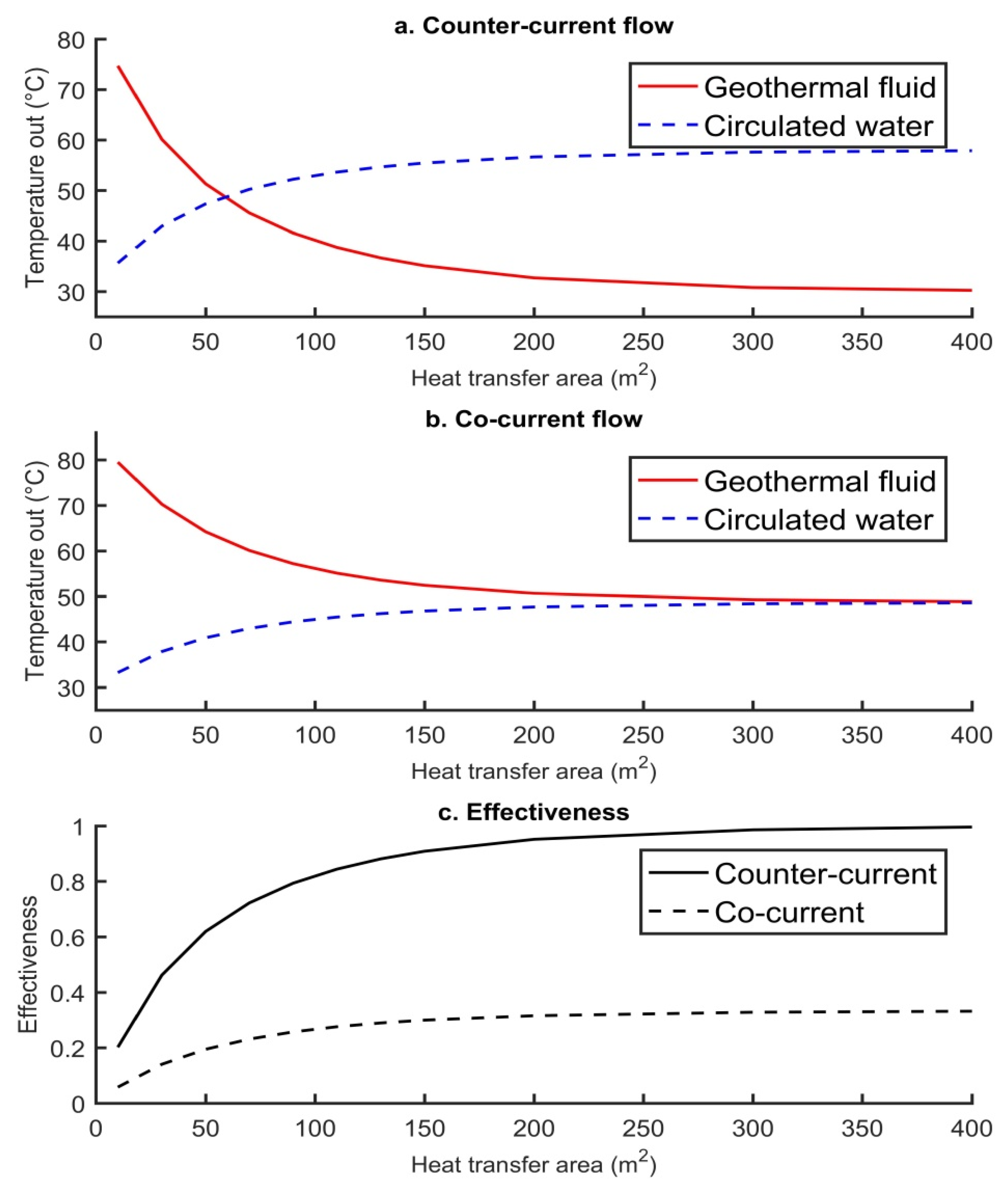
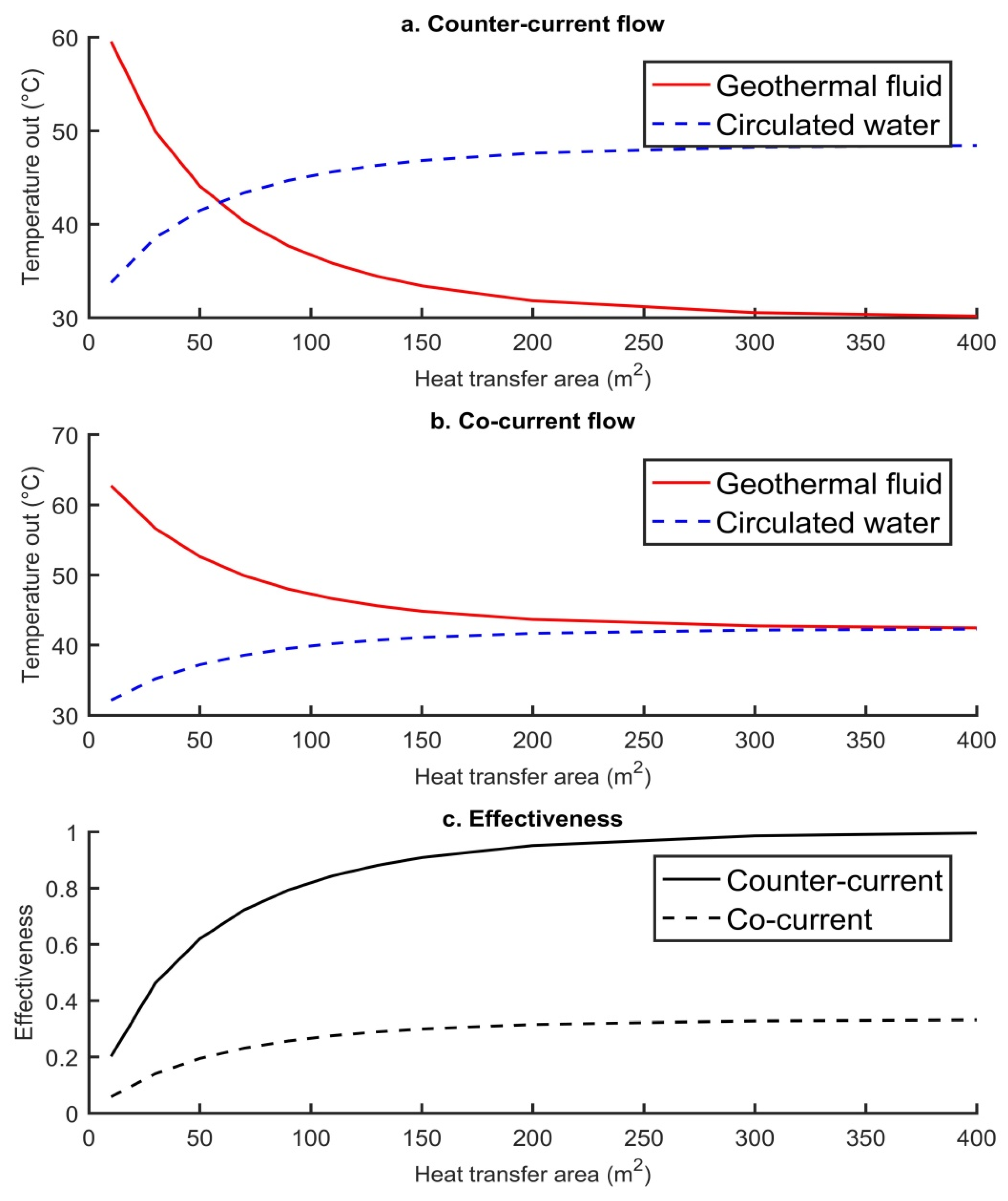


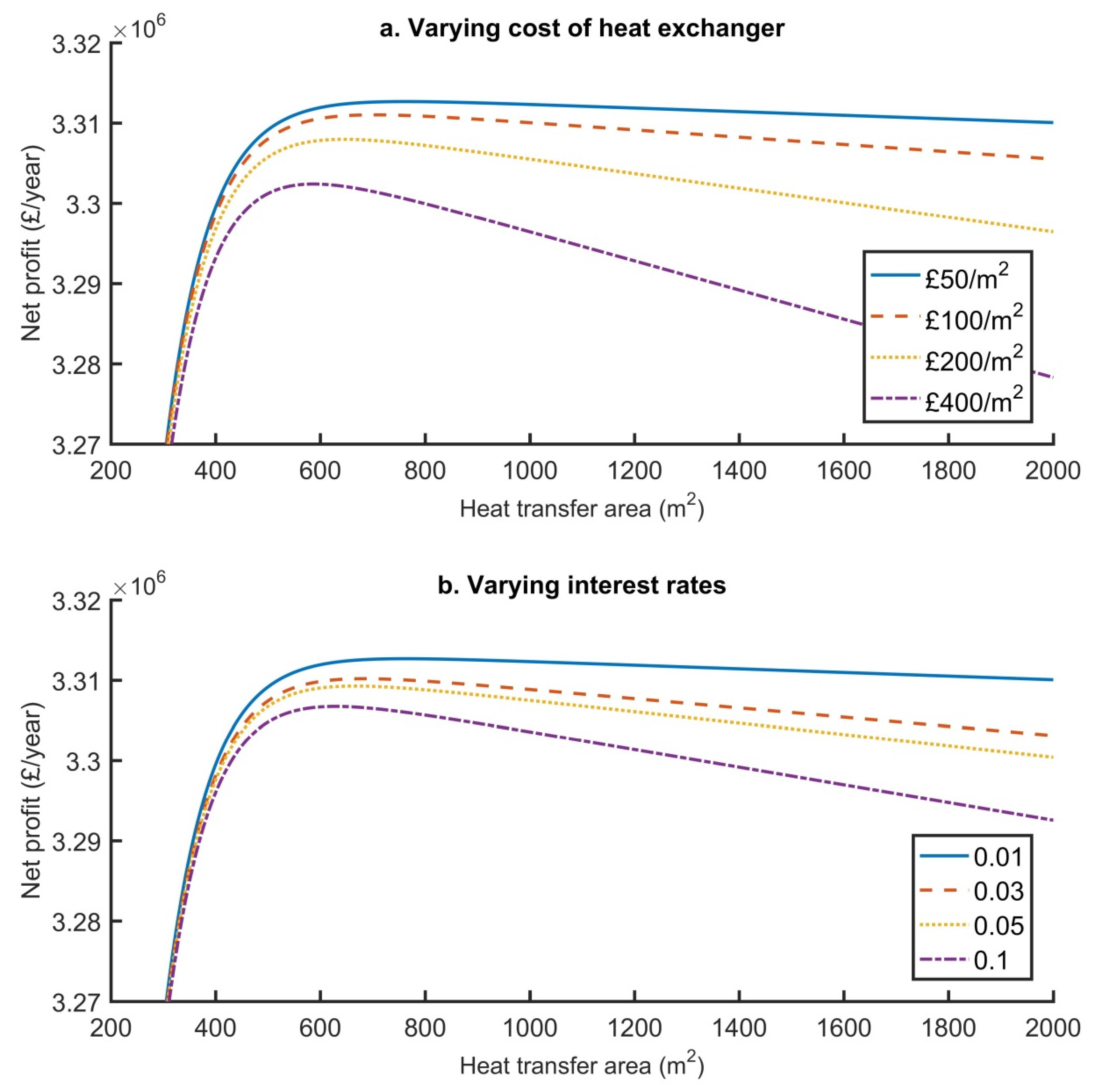
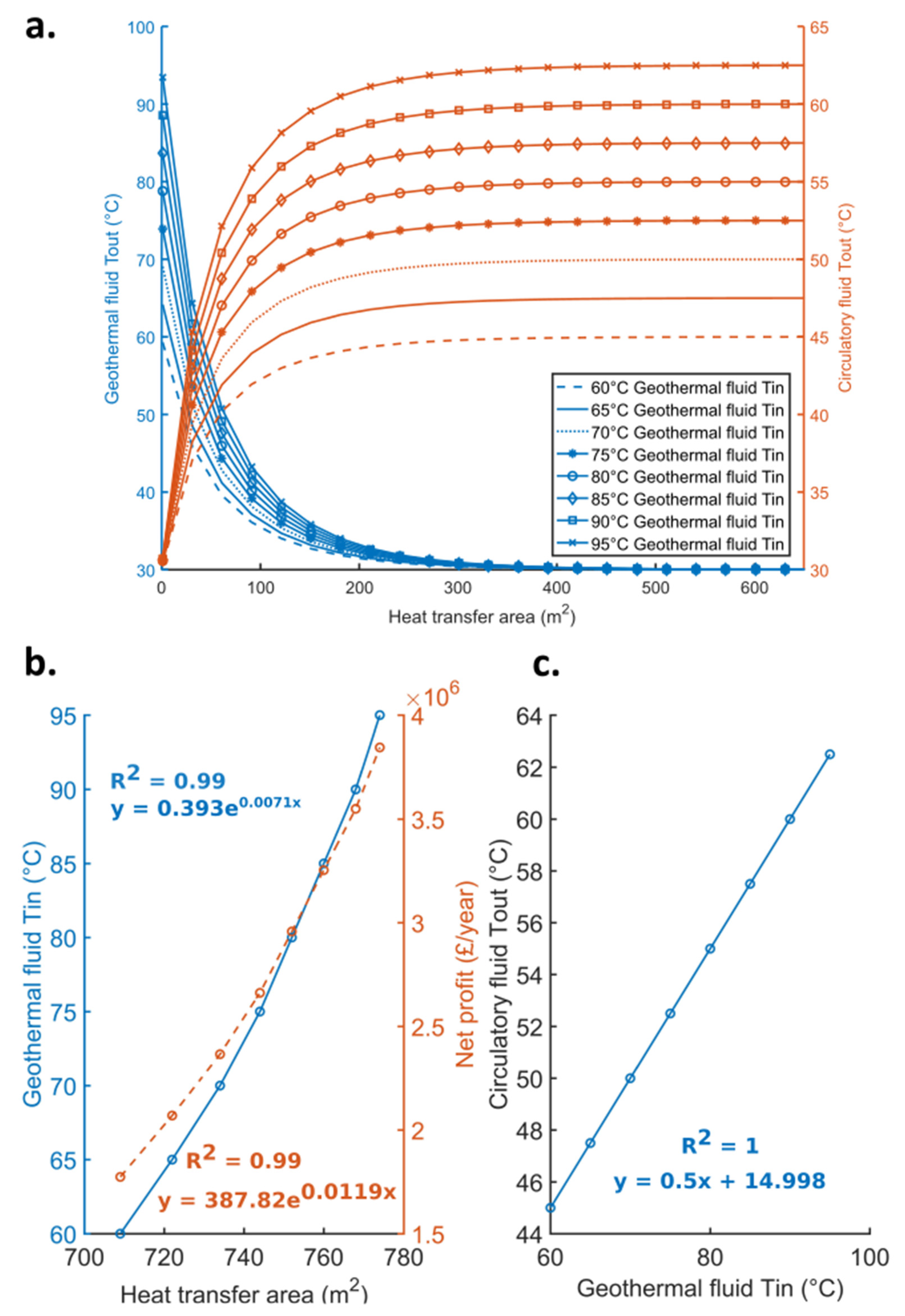
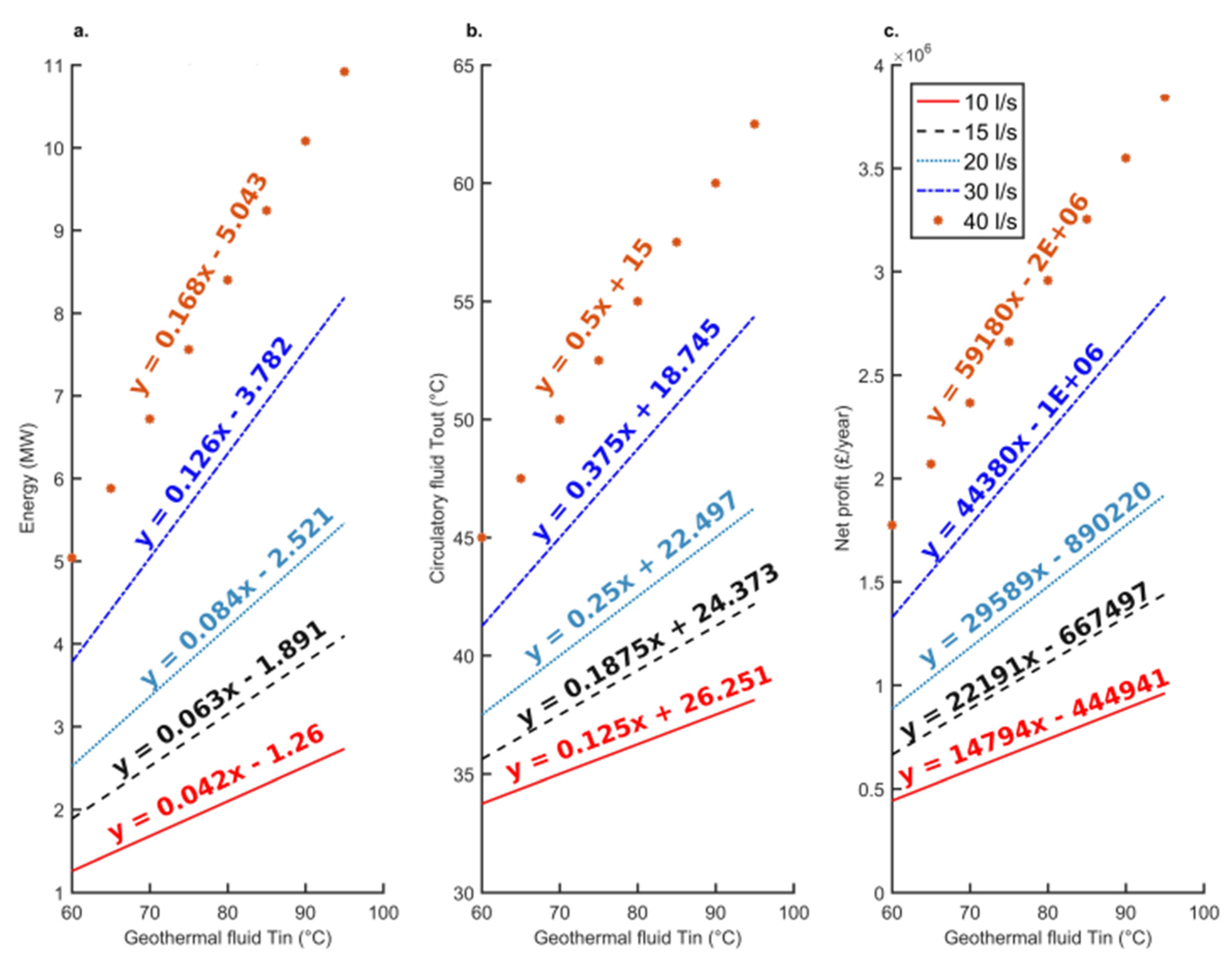
| Heat Exchanger (£/m2) | Optimum Heat Transfer Area (m2) |
|---|---|
| 50 | 727 |
| 100 | 669 |
| 200 | 611 |
| 400 | 553 |
| Interest Rate (i) | Optimum Heat Transfer Area (m2) |
| 0.01 | 727 |
| 0.03 | 649 |
| 0.05 | 631 |
| 0.1 | 594 |
| Heat Exchanger Cost per m2 (£/m2) | Optimum Heat Transfer Area (m2) |
|---|---|
| 50 | 762 |
| 100 | 704 |
| 200 | 645 |
| 400 | 587 |
| Interest Rate (i) | Optimum Heat Transfer Area (m2) |
| 0.01 | 762 |
| 0.03 | 684 |
| 0.05 | 666 |
| 0.1 | 629 |
Publisher’s Note: MDPI stays neutral with regard to jurisdictional claims in published maps and institutional affiliations. |
© 2022 by the authors. Licensee MDPI, Basel, Switzerland. This article is an open access article distributed under the terms and conditions of the Creative Commons Attribution (CC BY) license (https://creativecommons.org/licenses/by/4.0/).
Share and Cite
Brown, C.S.; Cassidy, N.J.; Egan, S.S.; Griffiths, D. Thermal and Economic Analysis of Heat Exchangers as Part of a Geothermal District Heating Scheme in the Cheshire Basin, UK. Energies 2022, 15, 1983. https://doi.org/10.3390/en15061983
Brown CS, Cassidy NJ, Egan SS, Griffiths D. Thermal and Economic Analysis of Heat Exchangers as Part of a Geothermal District Heating Scheme in the Cheshire Basin, UK. Energies. 2022; 15(6):1983. https://doi.org/10.3390/en15061983
Chicago/Turabian StyleBrown, Christopher S., Nigel J. Cassidy, Stuart S. Egan, and Dan Griffiths. 2022. "Thermal and Economic Analysis of Heat Exchangers as Part of a Geothermal District Heating Scheme in the Cheshire Basin, UK" Energies 15, no. 6: 1983. https://doi.org/10.3390/en15061983






